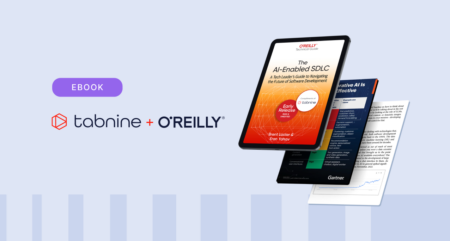
Get free early access to the upcoming O’Reilly Guide, The AI-Enabled SDLC: A Tech Leader’s Guide to Navigating the Future of Software Development.
Every company, no matter its size or sector, strives to produce high-quality software at the lowest cost and in the shortest time possible. To achieve this, technical teams have traditionally used a software development life cycle (SDLC) process — a well-structured flow of phases that enable the design and delivery of first-class software that is well tested and ready for production.
Now, AI is transforming the traditional SDLC. Taking optimum advantage of the powerful capabilities that AI unlocks in each phase of the SDLC (as well as competing effectively) means that today’s development teams need to learn new tools and techniques. But what are these, exactly, and what is the best way to adopt AI tools into your software development pipeline?
An upcoming new book from Tabnine founder Eran Yahav and co-author Brent Laster will offer answers to these critical questions. The AI-Enabled SDLC: A Tech Leader’s Guide to Navigating the Future of Software Development, to be published early in 2025 by O’Reilly Media, will help engineering leaders and hands-on engineers alike understand how AI tools can improve each stage of their SDLC. The book will offer pragmatic guidance for technical leaders on how you can adapt their current software development processes, adopt AI-enabled software development tools, and enable your teams to be successful with AI tools. It will also be a valuable reference as you apply your newly gained knowledge in revising how your teams work and the tools they use.
The AI-Enabled SDLC uses the SDLC’s seven core stages (plan, create, test, fix, document, explain, and maintain) as the framework to examine and explain how the adoption and use of AI is fundamentally reshaping each one:
Rather than waiting until the entire book is ready for publication, the authors are using a rapid release approach to make this information available as quickly as possible. The first three chapters of The AI-Enabled SDLC: A Tech Leader’s Guide to Navigating the Future of Software Development are now available, and Tabnine will be releasing updates to the guide as each chapter becomes available.
Downloading the first three chapters gives early readers a head start on understanding the role of LLMs in software development. Here’s what the initial set of chapters explores:
Subsequent chapters build upon this knowledge to cover things the software industry has never before needed to consider: simplifying code translation (e.g., COBOL to Java) with AI tools; code creation and new feature development using natural language; and optimizing an AI tool’s context awareness to ensure it returns the highest quality recommendations.
Join this learning curve at the earliest possible point by downloading the first three chapters — and then stay ahead by signing up to receive new chapters as soon as they become available.